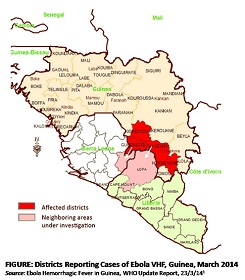Large outbreak of Ebola Viral Haemorrhagic Fever in Guinea, West Africa
The World Health Organization (WHO) is reporting an extensive outbreak of Ebola Viral haemorrhagic fever in forested areas in the southeast of Guinea in West Africa.1
As of 22 March 2014, a total of 49 cases including 29 deaths (giving a case fatality ratio of 59%) have been reported in Guinea. Cases have been identified in Guekedou, Macenta, Nzerekore and Kissidougou districts. In addition, three suspect cases (including two deaths) in Guinea’s capital, Conakry are under investigation. Four health care workers are amongst those known to have been infected. Coincidentally, investigations are being undertaken into reports of suspected cases in border areas of adjoining Liberia and Sierra Leone.
Seven blood samples have been tested for Ebola virus at the VHF Reference Facility at Institut Pasteur in Lyon, France; six of these have been confirmed as being positive for Ebola virus by PCR, making this the first confirmed Ebola haemorrhagic fever outbreak in Guinea. Preliminary genome sequencing results have shown strong homology with Zaire Ebola virus.
The Ministry of Health (MoH) in Guinea working in collaboration with WHO partners have instituted control measures locally including deployment of multidisciplinary field teams to seek and identify cases, identify and actively manage controls, to communicate prevention and control measures (including early reporting and management of suspected cases) to health care facilities and the local population. In addition, Médecins Sans Frontières, Switzerland (MSF-CH) is working in the affected areas and is assisting in the establishment of isolation facilities, transport of the biological samples to international reference facilities for urgent detection and characterisation. International collaboration is directed also towards ensuring local Filovirus diagnostic capacity in Guinea and Sierra Leone.
WHO and other partners are mobilizing and deploying additional experts, supplies and logistics to provide support to the Guinean authorities. Given the rapidly evolving nature of this outbreak reported figures are likely to change. WHO has not recommended that any travel or trade restrictions be applied to Guinea in respect to this event.
Travellers returning from Guinea: Any travellers returning from a trip to (or travel through) the affected areas, and who present with a fever >380C (or a history of fever at any stage in the last 24 hours) within 21 days of their return should be assessed using the Viral Haemorrhagic Fever algorithm and clinical assessment forms available on the HPSC website.
Further information on Ebola VHF can be found on the HPSC website. Information on endemic areas and recent outbreaks of VHFs is available here.

References
1. WHO. Ebola Hemorrhagic Fever in Guinea. Update News Report. Available at http://www.afro.who.int/en/clusters-a-programmes/dpc/epidemic-a-pandemic-alert-and-response/outbreak-news/4063-ebola-hemorrhagic-fever-in-guinea.html. Accessed 24/3/2014.


